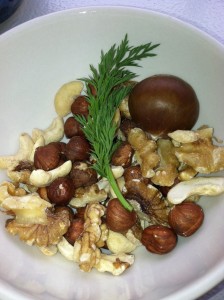Monthly Archives: January 2014
 In November of 2013 there was a media feeding frenzy when a large study demonstrated that people who ate even small amounts of nuts had an overall “7% reduced risk of dying from any cause during the 30 year study.”(Health Day from Medline © 2013). It also revealed that the more nuts people ate the more they reduced their risk of dying peaking at a 20% reduction for the highest consumers. Previous studies have demonstrated that eating nuts reduces incidence and risk for diabetes, heart disease, memory loss and obesity. (I”m not referencing these because there are too many to sift through).
In November of 2013 there was a media feeding frenzy when a large study demonstrated that people who ate even small amounts of nuts had an overall “7% reduced risk of dying from any cause during the 30 year study.”(Health Day from Medline © 2013). It also revealed that the more nuts people ate the more they reduced their risk of dying peaking at a 20% reduction for the highest consumers. Previous studies have demonstrated that eating nuts reduces incidence and risk for diabetes, heart disease, memory loss and obesity. (I”m not referencing these because there are too many to sift through).
There are several possible explanations for this but only time will tell. Here are a couple. First, fats, unlike protein and carbohydrates, have a unique ability to signal fullness. Fats do this through a chemical called leptin. It’s possible that simply eating nuts helps to reduce overconsumption of other foods. Second, omega-9 fats, which are predominant in nuts, send signals that talk directly to your DNA to reduce inflammation and cholesterol production, and increase the effectiveness of insulin. As I discuss in my article in Rejuvenation Research Journal, this works through a switch on the cell’s nucleus called PPAR which we know is activated by omega-9 oils. doi:10.1089/rej.2013.1485
In conclusion, eat at least a handful of nuts per day. Not seeds, nuts. Olive oil also contains the same beneficial oils. Try eating nuts before dinner. Since the fats help to signal fullness, it may help to reduce overeating. Later, I will discuss the nuances of deriving maximum benefit from nuts.
 I seek to cure what’s deep inside, frightened of this thing that I’ve become.
I seek to cure what’s deep inside, frightened of this thing that I’ve become.
-Toto
Around 20 years ago, both the National Institute of Health and The World Health Organization released separate, independent studies concluding that genetics only plays a minor role in the development of cancer. Most of us were completely surprised to find that environmental and lifestyle factors influenced over 80% of this outcome. Since then, several large studies have unveiled similar statistics including the development of heart disease and diabetes. The belief that we are mere victims to our genetic programing has given way to the realization that, with some accurate knowledge, we have incredible influence over our health as we move forward in our lives. In science, the term that describes the accumulation outside factors upon an organism’s genes is called “phenotype” (pronounced fee-no-type). What is your phenotype? What do you want it to be? Of course there are things that we cannot control. However, always remember, you have incredible influential powers to create and re-create your life and your future.
In spring time learn, in harvest teach, in winter enjoy.
-William Blake
The ancient Chinese physicians believed that, like plants moving their resources deep into the Earth during the dark winter months, the energy of the body also moved into the deepest parts to rejuvenate tissues like bone and marrow. When we think of bone the first mineral we think of is calcium. However, the bones are reservoirs of minerals like magnesium, potassium, zinc, copper, and strontium. Studies going back more than thirty years have demonstrated that these less-known minerals are as important for bone health as calcium. Diets in the developed world have moved in a direction that provides fewer and fewer minerals. Many of the mineral-rich foods that used to be mainstays of our diets like heart, kidney, roots, kelp, sea salt and even bone have fallen out of favor. Instead of eating the whole animal, which provides a flood of minerals from the Earth, we’ve limited ourselves to only muscle. Since it is very common for bone tissue to age faster than many other tissues of the body, we will revisit this subject again and again. It’s a very complex subject. If you are feeling motivated, here is a post I wrote several years ago about the complexities of alkalizing foods and bone aging. For now, here are some simple steps to begin to bring minerals back into your diet.
- Replace your table salt which contains only sodium with sea salt which contains an array of minerals.
- Try some coconut water. Be sure to get the one with no sugar added. It’s slightly alkaline taste is a result of the abundance of potassium.
- Eat sardines with the bones left in. The wild ones definitely taste better and are worth the bit of extra money.
- Make some bone broth. This can be done by adding bones, like beef ribs or bone-in chicken or turkey. Simply boil these down into a nice consommé. Adding a little lemon of vinegar to acidify the water helps to dissolve the minerals into the water. Be sure to add some sea salt. Eat this on its own or use it as a base for other recipes.
- If you live in an area where you can get Japanese food, try some seaweed salad or miso soup. Both of these are abundant in absorbable minerals. You might be surprised that you actually like it. If you don’t, I will be posting a breakfast seaweed recipe soon that I promise tastes good.
- Try some organ meats. If you live in a country like the US where the taste for these foods is very unfamiliar start with a little liver pate’.
- Eat more root vegetables like beets, burdock, parsnips and carrots….Have you ever eaten a fresh beet? It’s like infusing yourself with the fragrance of the Earth.
Everyday, science teaches us something new about the benefits of the various chemicals found in plants. Many common herbs and spices have powerful health benefits. As we move forward we will explore more herbs.
Both parsley and cilantro contain compounds that help enhance elimination of toxic heavy metals. Heavy metals are known to interfere with normal cellular function by blocking enzymes that help to drive normal processes. Over time, this interference can damage tissues. Including cilantro or parsley in your daily routine can help eliminate mercury from fish and coal emissions, cadmium from air pollution and cigarette smoke and aluminum from antiperspirants and antacids. Since most fish is particularly high in mercury, adding parsley or cilantro to a side salad is an effective way to reduce mercury absorption. In addition, studies have demonstrated cilantro’s powerful ability to help regulate blood sugar, lower “bad” LDL cholesterol and raise “good” HDL cholesterol.
Cruciferous vegetables like broccoli, cauliflower, Brussels’s sprouts, cabbage, bok choy and kale all contain chemicals called indoles. Scores of studies over the past 20 years have shown that indoles help to prevent the development and spread of estrogen-sensitive cancer cells in prostate and breast tissue. Recent research showed that breast tissue ages faster than any other tissue in the body. It is hypothesized that this happens because the hormone, estrogen, causes breast tissue cells to reproduce more rapidly than most other tissues in the body. As a result, these cells lose their telomeres faster and eventually can no longer divide. Indoles help to weaken the growth-stimulating effects of estrogen. In dietary therapy, these vegetables are prescribed in amounts from 1/2 cup up to 3 cups per day.
If you don’t know how to cook, a simple way to prepare these vegetables is to just steam them for a few minutes. Quite delicious with a little butter, sea salt and a spritz of lemon juice.
A quick note; Ladies, if you are trying to become pregnant, the estrogen-lowering effects of these vegetables may lower your fertility. Gentleman, for you this improves fertility and helps to prevent testosterone from being converted into estrogen.
 Take advantage of winter’s long hours of darkness to help your body naturally build immunity, improve fat loss, promote deeper sleep, slow cellular aging and reduce your risk of cancer . Melatonin, a well-studied hormone, is made in the pineal gland is produced in the absence of light. Minimizing your exposure to light and sleeping in total darkness helps to increase production of melatonin. As I mention in a previous post, even light shining through a cracked door is enough to dramatically plummet melatonin levels.
Take advantage of winter’s long hours of darkness to help your body naturally build immunity, improve fat loss, promote deeper sleep, slow cellular aging and reduce your risk of cancer . Melatonin, a well-studied hormone, is made in the pineal gland is produced in the absence of light. Minimizing your exposure to light and sleeping in total darkness helps to increase production of melatonin. As I mention in a previous post, even light shining through a cracked door is enough to dramatically plummet melatonin levels.